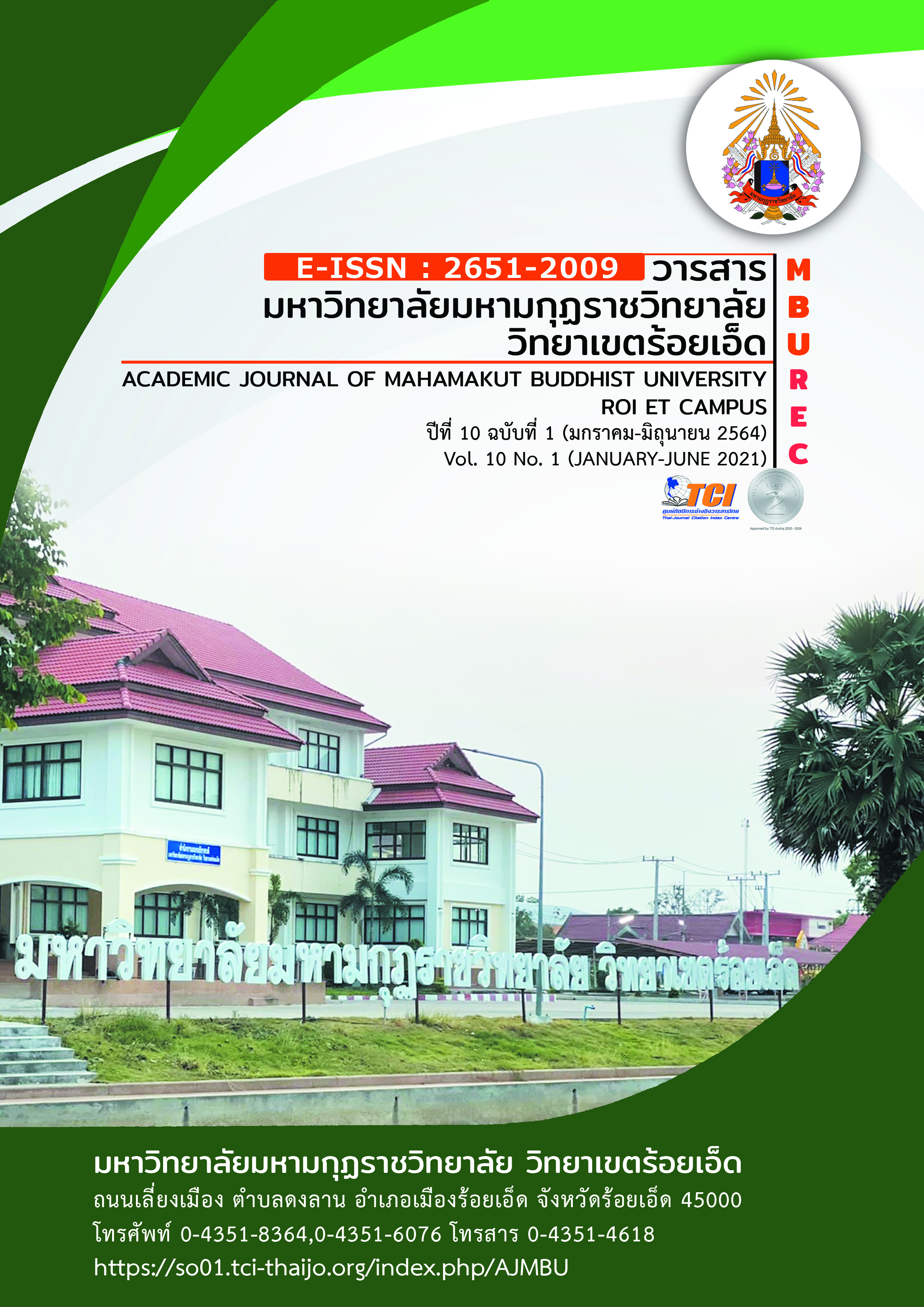The Guidelines for Preserving and Inheriting Local Wisdom Through Singing the Isan-Styled Sarabhañña of Nong Takai Villagers, Si Kaew Subdistrict, Mueang District, Roi Et Province
Main Article Content
Abstract
The objectives of the research article were 1) to study the concepts, composition, and development of Sarabhañña singing appearing in Buddhism and 2) to study the concepts for preserving and inheriting local wisdom through Sarabhañña singing of Nong Takai villagers, Si Kaew subdistrict, Mueang district, Roi Et province. The research area is Nong Takai villagers, Si Kaew subdistrict, Mueang district, Roi Et province. The key informants consist of local scholars, those who teach the Sarabhañña singing, as well as those who sing Sarabhañña. The instruments used in the research are the unstructured interview along with the field study recording, in which the researcher studies the data based on the document analysis, participatory observation, and in-depth interviews by using the triangulation method. The qualitative data is analyzed based on the analytic induction. The data is concluded through document methodology, in-depth interviews, and group discussions.
The research findings found that : 1) the Sarabhañña singing consists of three important compositions, namely: (1) the writer of Sarabhañña is experienced with an ability to compose the Sarabhañña; (2) most content of Sarabhañña is the story about Buddhism, moral and ethical principles, Jakata tales, literature, and Isan customs; and (3) those who sing Sarabhañña refers to any layman or student who are interested in singing Sarabhañña. 2) The context and problems in preserving the local wisdom regarding Sarabhañña singing are that the present society has changed from the past in a way that the younger generation goes to the temple much less often and are not interested in Sarabhañña singing as in the past due to the lack of motivation. In addition, the community also pays less importance and attention to this. 3) The study also shows that the Sarabhañña singing of Nong Takai villagers is the preservation and inheritance of local wisdom and an act of respect and devotion to the Triple Gem by believing and having faith in Buddhism that it can elevate the people's mind to carry on the Isan local culture on Sarabhañña singing.
Article Details
References
กรมการศาสนา กระทรวงวัฒนธรรม. (2549). การสวดมนต์หมู่สรรเสริญพระรัตนตรัยทำนองสรภัญญะ. กรุงเทพมหานคร : โรงพิมพ์ชุมชนสหกรณ์การเกษตรแห่งประเทศไทย.
ธัญญพร มาบวบ. (2560). แนวทางอนุรักษ์สืบสานภูมิปัญญาท้องถิ่น ด้านศิลปะการแสดงการขับร้องสรภัญญะทำนองอีสานกรณีศึกษา ตำบลบึงกระจับ อำเภอวิเชียรบุรี จังหวัดเพชรบูรณ์. รายงานวิจัย. สำนักศิลปะและวัฒนธรรม : มหาวิทยาลัยราชภัฏพิบูลสงคราม.
พระวันนี ขนฺติพโล(ขันตีกุล), โสวิทย์ บำรุงภักดิ์, พระมหาดาวสยาม วชิรปญฺโญ. (2562). การศึกษาคติธรรมทางพระพุทธศาสนาในพิธีกรรมการบูชาปู่เซียงน้อยของชาวตำบลบ้านเป้า อำเภอเกษตรสมบูรณ์ จังหวัดชัยภูมิ. วารสารมหาวิทยาลัยมหามกุฏราชวิทยาลัย วิทยาเขตร้อยเอ็ด. 8(2). 281-289.
มโนรส จันทร์พิทักษ์. (2550) การสื่อสารเพื่อการรื้อฟื้นและสืบทอดการสวดสรภัญญะที่บ้านใหม่สมบูรณ์อำเภอหนองบุญมาก จังหวัดนครราชสีมา. วิทยานิพนธ์นิเทศศาสตรมหาบัณฑิต. คณะนิเทศศาสตร์ : จุฬาลงกรณ์มหาวิทยาลัย.
มูลนิธิสารานุกรมวัฒนธรรมไทย ธนาคารไทยพาณิชย์. (2542). สารานุกรมวัฒนธรรมไทย ภาคอีสาน. กรุงเทพมหานคร : มูลนิธิสารานุกรมวัฒนธรรมไทย ธนาคารไทยพาณิชย์.
ราชบัณฑิตยสถาน. (2542). พจนานุกรมฉบับราชบัณฑิตยสถาน. กรุงเทพมหานคร : โรงพิมพ์ราชบัณฑิตยสถาน.
สวิง บุญเจิม. (2536). มรดกอีสาน. พิมพ์ครั้งที่ 4. อุบลราชธานี : สำนักพิมพ์มรดกอีสาน.
สุทัศน์ ประทุมแก้ว, อุทัย ภูคดหิน. (2562). แซนโฎนตา : ความเชื่อของชุมชนด้านการประกอบพิธีกรรม อำเภอขุขันธ์ จังหวัดศรีสะเกษ. วารสารมหาวิทยาลัยมหามกุฏราชวิทยาลัย วิทยาเขตร้อยเอ็ด. 8(2). 171-180.


